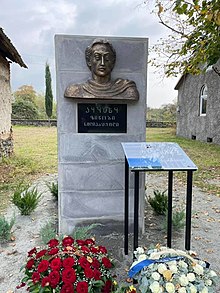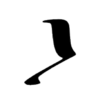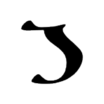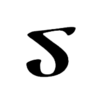Caucasian Albanian script
| Caucasian Albanian | ||
|---|---|---|
MS No. 7117, fol. 142r | ||
| Script type | ||
| Creator | Unicode range | U+10530–U+1056F Final Accepted Script Proposal |
The Caucasian Albanian script was an
It was used to write the
History
According to Movses Kaghankatvatsi, the Caucasian Albanian script was created by Mesrop Mashtots,[3][4][5] the Armenian monk, theologian and translator who is also credited with creating the Armenian and—by some scholars—the Georgian scripts.[6][7][8][9][10]
Koriun, a pupil of Mesrop Mashtots, in his book The Life of Mashtots, wrote about the circumstances of its creation:
Then there came and visited them an elderly man, an Albanian named Benjamin. And he, Mesrop Mashtots, inquired and examined the barbaric diction of the Albanian language, and then through his usual God-given keenness of mind invented an alphabet, which he, through the grace of Christ, successfully organized and put in order.[11]
The alphabet was in use from its creation in the early 5th century through the 12th century, and was used not only formally by the Church of Caucasian Albania, but also for secular purposes.[12]
Rediscovery

Although mentioned in early sources, no examples of it were known to exist until its rediscovery in 1937 by a Georgian scholar, Professor
Between 1947 and 1952, archaeological excavations at Mingachevir under the guidance of S. Kaziev found a number of artifacts with Caucasian Albanian writing — a stone altar post with an inscription around its border that consisted of 70 letters, and another 6 artifacts with brief texts (containing from 5 to 50 letters), including candlesticks, a tile fragment, and a vessel fragment.[14]
The first literary work in the Caucasian Albanian alphabet was discovered on a
Legacy

The Udi language, spoken by some 8,000 people, mostly in the Republic of Azerbaijan but also in Georgia and Armenia,[18] is considered to be the last direct continuator of the Caucasian Albanian language.[19][20]
Characters
The script consists of 52 characters, all of which can also represent numerals from 1 to 700,000 when a combining mark is added above, below, or both above and below them, described as similar to Coptic. 49 of the characters are found in the Sinai palimpsests.[21] Several punctuation marks are also present, including a middle dot, a separating colon, an apostrophe, paragraph marks, and citation marks.
Letters
| Caucasian Albanian | |||||
|---|---|---|---|---|---|
| Sinai Palimpsest | Matenadaran Manuscript 7117 | Unicode | Numeric value | Letter Name | Pronunciation |

|

|
𐔰 | 1 | Alt | /a/ |

|

|
𐔱 | 2 | Bet | /b/ |

|

|
𐔲 | 3 | Gim | /g/ |

|

|
𐔳 | 4 | Dat | /d/ |

|

|
𐔴 | 5 | Eb | /e/ |

|

|
𐔵 | 6 | Zarl | /z/ |

|

|
𐔶 | 7 | Eyn | /eː/ |

|

|
𐔷 | 8 | Zhil | /ʒ/ |

|

|
𐔸 | 9 | Tas | /t/ |

|

|
𐔹 | 10 | Cha | /t͡ɕʼ/ |

|

|
𐔺 | 20 | Yowd | /j/ |

|

|
𐔻 | 30 | Zha | /ʑ/ |

|

|
𐔼 | 40 | Irb | /i/ |

|

|
𐔽 | 50 | Sha | /ˤ/ |

|

|
𐔾 | 60 | Lan | /l/ |

|

|
𐔿 | 70 | Inya | /nʲ/ |

|

|
𐕀 | 80 | Xeyn | /x/ |

|

|
𐕁 | 90 | Dyan | /dʲ/ |

|

|
𐕂 | 100 | Car | /t͡sʼ/ |

|

|
𐕃 | 200 | Jhox | /d͡ʑ/ |

|

|
𐕄 | 300 | Kar | /k'/ |

|

|
𐕅 | 400 | Lyit | /lʲ/ |

|

|
𐕆 | 500 | Heyt | /h/ |

|

|
𐕇 | 600 | Qay | /q/ |

|

|
𐕈 | 700 | Aor | /ɒ/ |

|

|
𐕉 | 800 | Choy | /t͡ɕ/ |

|

|
𐕊 | 900 | Chi | /t͡ʃʼ/ |

|

|
𐕋 | 1000 | Cyay | /t͡sʲ/ |

|

|
𐕌 | 2000 | Mak | /m/ |

|

|
𐕍 | 3000 | Qar | /q'/ |

|

|
𐕎 | 4000 | Nowc | /n/ |

|

|
𐕏 | 5000 | Dzyay | /d͡zʲ/ |

|

|
𐕐 | 6000 | Shak | /ʃ/ |

|

|
𐕑 | 7000 | Jayn | /d͡ʒ/ |

|

|
𐕒 | 8000 | On | /o/ |

|

|
𐕓 | 9000 | Tyay | /tʲʼ/ |

|

|
𐕔 | 10000 | Fam | /f/ |

|

|
𐕕 | 20000 | Dzay | /d͡z/ |

|

|
𐕖 | 30000 | Chat | /t͡ʃ/ |

|

|
𐕗 | 40000 | Pen | /p'/ |

|

|
𐕘 | 50000 | Gheys | /ɣ/ |

|

|
𐕙 | 60000 | Rat | /r/ |

|

|
𐕚 | 70000 | Seyk | /s/ |

|

|
𐕛 | 80000 | Veyz | /v/ |

|

|
𐕜 | 90000 | Tiwr | /t'/ |

|

|
𐕝 | 100000 | Shoy | /ɕ/ |

|

|
𐕞 | 200000 | Iwn | /y/ |

|

|
𐕟 | 300000 | Cyaw | /t͡sʲʼ/ |

|

|
𐕠 | 400000 | Cayn | /t͡s/ |

|

|
𐕡 | 500000 | Yayd | /w/ |

|

|
𐕢 | 600000 | Piwr | /p/ |

|

|
𐕣 | 700000 | Kiw | /k/ |
Unicode
The Caucasian Albanian alphabet was added to the Unicode Standard in June, 2014 with the release of version 7.0.
The Unicode block for Caucasian Albanian is U+10530–1056F:
| Caucasian Albanian[1][2] Official Unicode Consortium code chart (PDF) | ||||||||||||||||
| 0 | 1 | 2 | 3 | 4 | 5 | 6 | 7 | 8 | 9 | A | B | C | D | E | F | |
| U+1053x | 𐔰 | 𐔱 | 𐔲 | 𐔳 | 𐔴 | 𐔵 | 𐔶 | 𐔷 | 𐔸 | 𐔹 | 𐔺 | 𐔻 | 𐔼 | 𐔽 | 𐔾 | 𐔿 |
| U+1054x | 𐕀 | 𐕁 | 𐕂 | 𐕃 | 𐕄 | 𐕅 | 𐕆 | 𐕇 | 𐕈 | 𐕉 | 𐕊 | 𐕋 | 𐕌 | 𐕍 | 𐕎 | 𐕏 |
| U+1055x | 𐕐 | 𐕑 | 𐕒 | 𐕓 | 𐕔 | 𐕕 | 𐕖 | 𐕗 | 𐕘 | 𐕙 | 𐕚 | 𐕛 | 𐕜 | 𐕝 | 𐕞 | 𐕟 |
| U+1056x | 𐕠 | 𐕡 | 𐕢 | 𐕣 | 𐕯 | |||||||||||
| Notes | ||||||||||||||||
References
- .
- ^ Peter R. Ackroyd. The Cambridge history of the Bible. — Cambridge University Press, 1963. — vol. 2. — p. 368:"The third Caucasian people, the Albanians, also received an alphabet from Mesrop, to supply scripture for their Christian church. This church did not survive beyond the conquests of Islam, and all but few traces of the script have been lost..."
- . "Rather, we have to assume that Old Udi corresponds to the language of the ancient Gargars (cf. Movsēs Kałankatuac‘i who tells us that Mesrop Maštoc‘ (362-440) created with the help [of the bishop Ananian and the translator Benjamin] an alphabet for the guttural, harsh, barbarous, and rough language of the Gargarac‘ik‘)."
- ^ К. В. Тревер. Очерки по истории и культуре Кавказской Албании. М—Л., 1959:"Как известно, в V в. Месроп Маштоц, создавая албанский алфавит, в основу его положил гаргарское наречие албанского языка («создал письмена гаргарского языка, богатого горловыми звуками»). Это последнее обстоятельство позволяет высказать предположение, что именно гаргары являлись наиболее культурным и ведущим албанским племенем."
- ^ Peter R. Ackroyd. The Cambridge history of the Bible. — Cambridge University Press, 1963. — vol. 2. — p. 368:"The third Caucasian people, the Albanians, also received an alphabet from Mesrop, to supply scripture for their Christian church. This church did not survive beyond the conquests of Islam, and all but few traces of the script have been lost, and there are no remains of the version known."
- ISBN 0-7007-1163-5. P. 19. "The Georgian alphabet seems unlikely to have a pre-Christian origin, for the major archaeological monument of the first century 4IX the bilingual Armazi gravestone commemorating Serafua, daughter of the Georgian viceroy of Mtskheta, is inscribed in Greek and Aramaic only. It has been believed, and not only in Armenia, that all the Caucasian alphabets — Armenian, Georgian and Caucaso-Albanian — were invented in the fourth century by the Armenian scholar Mesrop Mashtots.<...> The Georgian chronicles The Life of Kanli – assert that a Georgian script was invented two centuries before Christ, an assertion unsupported by archaeology. There is a possibility that the Georgians, like many minor nations of the area, wrote in a foreign language — Persian, Aramaic, or Greek — and translated back as they read."
- ISBN 0-674-51173-5.
- ISBN 1402012985.
- ISBN 0-674-51173-5.
- ISBN 9783700170884.
- ^ Koriun, The life of Mashtots, Ch. 16.
- ^ Schulze, Wolfgang (2005). "Towards a History of Udi" (PDF). International Journal of Diachronic Linguistics: 1–27 [12]. Retrieved 4 July 2012. "In addition, a small number of inscriptions on candleholders, roofing tiles and on a pedestal found since 1947 in Central and Northern Azerbaijan illustrate that the Aluan alphabet had in fact been in practical use."
- ^ Ilia Abuladze. "About the discovery of the alphabet of the Caucasian Aghbanians". In the Bulletin of the Institute of Language, History and Material Culture (ENIMK), Vol. 4, Ch. I, Tbilisi, 1938.
- ISBN 978-0-226-45058-2
- ^ Zaza Alexidze; Discovery and Decipherment of Caucasian Albanian Writing "Archived copy" (PDF). Archived from the original (PDF) on 2011-07-21. Retrieved 2011-01-18.
{{cite web}}: CS1 maint: archived copy as title (link) - ^ Aleksidze, Zaza; Blair, Betty (2003). "Caucasian Albanian Alphabet: Ancient Script Discovered in the Ashes". Azerbaijan International.
- ^ Gippert, Jost / Schulze, Wolfgang / Aleksidze, Zaza / Mahé, Jean-Pierre: The Caucasian Albanian Palimpsests of Mount Sinai, 2 vols., XXIV + 530 pp.; Turnhout: Brepols 2009
- ^ Wolfgang Schulze, "The Udi Language", "Udi Grammar Contents". Archived from the original on 2009-08-26. Retrieved 2010-02-24.
- ^ The Arab geographers refer to the Arranian language as still spoken in the neighbourhood of Barda'a (Persian: Peroz-Abadh, Armenian Partav), but now only the two villages inhabited by the Udi are considered as the direct continuators of the Albanian linguistic tradition. V. Minorsky. Caucasica IV. Bulletin of the School of Oriental and African Studies, University of London, Vol. 15, No. 3. (1953), pp. 504–529.
- ^ "Caucasian Albanian Script. The Significance of Decipherment" (2003) by Dr. Zaza Alexidze.
- ^ Everson, Michael; Gippert, Jost (2011-10-28). "N4131R: Proposal for encoding the Caucasian Albanian script in the SMP of the UCS" (PDF). Working Group Document, ISO/IEC JTC1/SC2/WG2.
External links
- Armazi project:
